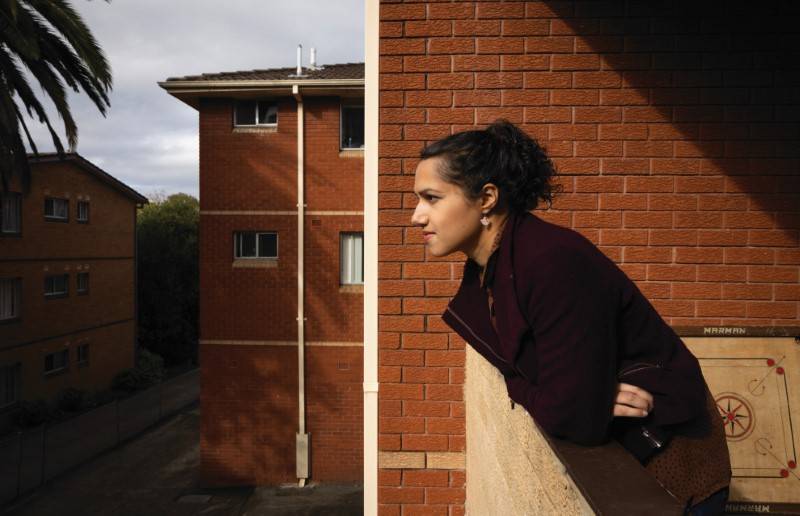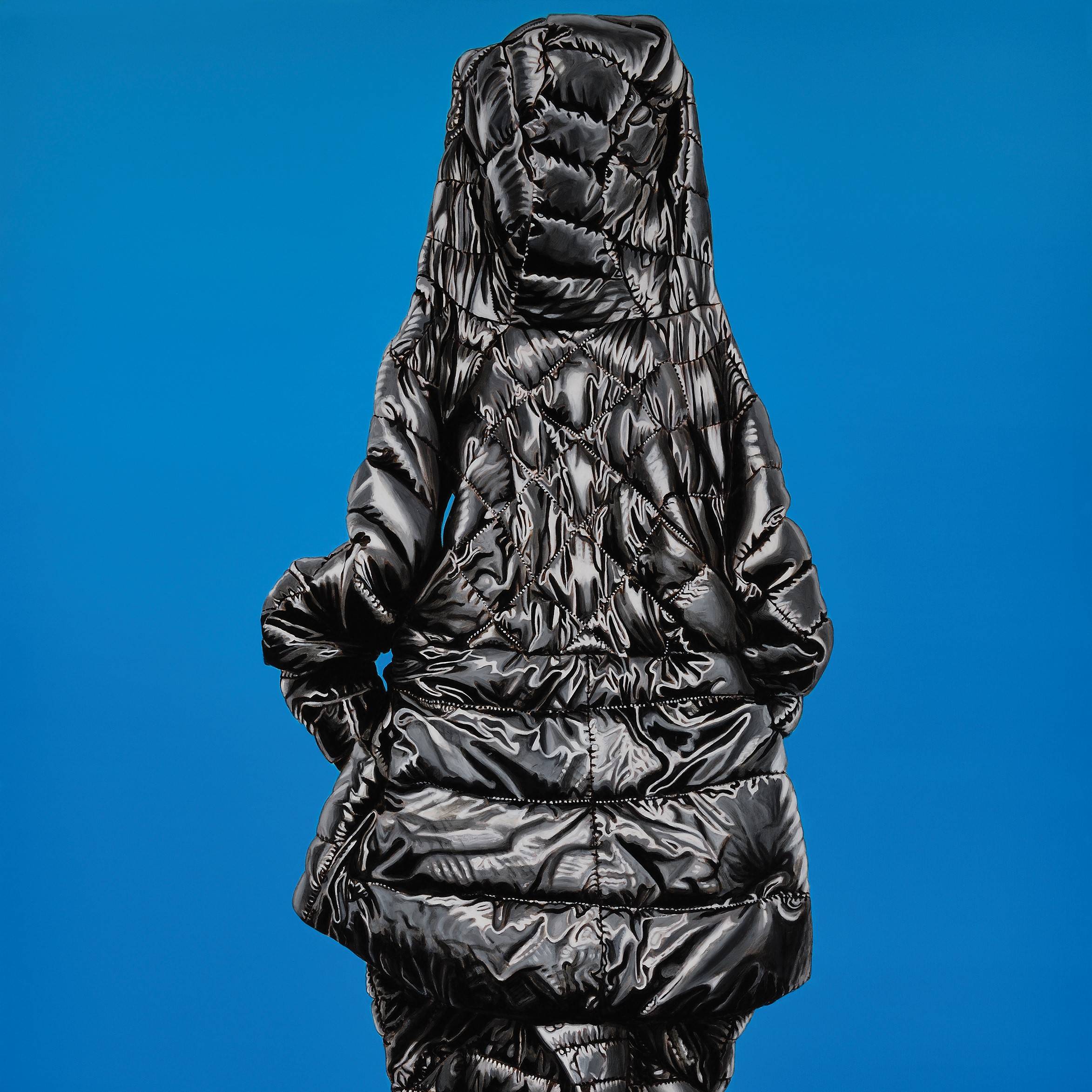Kirtika Kain: The Power of Art
Avoiding an aesthetics driven by victimhood, Kirtika Kain’s painterly approach to the identity of her caste, which continues to be dehumanised as untouchables, is an exciting explosion of joy, warmth and opulence, from which anger can still be felt.
Words: Judith Blackall
Photography: Jessica Hromas
Kirtika Kain’s quietly powerful paintings derive from her journey to understand and celebrate the ancient, complex lineage she inherited as one born into a Dalit family within the Indian caste system. To engage with the cultural knowledge and spiritual identity that fuel her art is an immersion into a profound, richly archaic world. How she examines caste, and chooses to explore identity through her art and research are both exciting and illuminating.
Kain was born in New Delhi in 1990 and immigrated as an infant to Australia with her parents and siblings. Growing up in Sydney’s northern beaches, an environment beyond the entrenched discrimination and oppression of the caste system, enabled reflection and exploration of her Dalit identity. Through extensive reading of Dalit literature and conversations with her family and connections within the international Dalit community of writers, philosophers and political commentators, Kain channels the immensity of her inherited Dalit experience through the immediacy of process and the nuance of materials.
The paintings in her recent body of work Blue Bloods explore the unexpected radiance to be found in the Dalit experience. Each painting is unique with richly saturated colour and a complex surface that can take weeks to build. The process is intense and intuitive, involving layering raw materials that are then compressed, erased, built upon and left to dry. Depth is created by blending the raw materials to form layers which are then consolidated with paints, pigments and other materials.
Kain’s raw materials include items associated with ritual and prayer, such as cotton wicks, ceremonial beads and bangles, grains, seeds and turmeric. These are mixed with oils and wax, or coagulated with pigments, paints, bitumen, and applications of gold and copper leaf. Tar – black and dense – is like a substrate; it adds contrast. Dark elements, a metaphor for the darker times and traumatic practices in societies, bring out the light.
For the artist, the intense saturation in each painting embodies personal and collective memories inspired particularly by her maternal ancestors. The paintings reflect the colour and depth of her community through a lens of warmth and opulence. Symbolically they convey the cycles of life, spirit and nature.
Kain has achieved a great deal in the five years since completing a Master of Fine Art at Sydney’s National Art School. She’s held two solo exhibitions with Roslyn Oxley9 Gallery, Sydney, and another three solo projects in cultural spaces in Sydney and London. She was a finalist in the Create NSW Emerging Artist Fellowship, and has undertaken studio residencies in Rome and New Delhi.
In 2022 she was nominated by José Roca, Colombian curator and Artistic Director of the 23rd Biennale of Sydney to participate in the prestigious Amant Studio & Research Residency Program near Siena. This unique professional opportunity enabled research and travel with other participants including leading international curators, artists, writers and musicians.
Artistic Directors of the 24th Biennale of Sydney, Cosmin Costinaș and Inti Guerrero have selected Kain’s work for inclusion in their Sydney Biennale exhibition Ten Thousand Suns from 9 March to 10 June 2024. Guerrero visited Kain in her Parramatta studio and describes the experience: “The moment I walked into Kirtika’s studio, I was entrapped by the force of colour coming from her paintings, which were all spread across every corner of the floor. Hung centred on a wall, almost like a shrine, was a framed portrait of B. R. Ambedkar; the political leader who piloted the Indian constitution and who, like Kirtika, was born into a Dalit caste. Rather than departing from an aesthetics driven by victimhood, Kirtika’s painterly approach towards the identity of a caste that had and continues to be dehumanised as untouchables, is on the contrary a lively explosion of joy and beauty from which anger can still be felt.”
Kain’s Blue Bloods conveys a resolute, new intelligence that brings fresh perspectives to the history and culture she embodies. Profoundly illuminating, the works’ immediacy and strength speak with determination and quiet resolve of the transformative power of art.
VISHAL KUMARASWAMY
Bangalore-based artist and curator
“I was looking for peers who were thinking through lived realities of caste in their practice when I came across Kirtika’s work in an article in The Sydney Morning Herald back in 2019. I was struck by the interplay of various materials in the works as they tackled complex socio-cultural positions.
“Kirtika’s relationship to ritualistic, ancestral materials and their grasp on the power of material memory is the first thing that caught my attention. Across the multiple disciplines that she works in, her ability to wrestle with the layered stories of her heritage and translate them into expansive bodies of works have been compelling in a way that is resonant across contexts.
“The rigour of Kain’s practice and the narratives that she explores in her works are expansive and include history, literature and embodied practices. Kirtika’s practice demonstrates a dedicated effort to bring forth socio-cultural contexts, language, casteised and racialised positions to the discourse in Australia and beyond.
“As someone who shares the same caste position as Kirtika, I am acutely aware of the systemic hindrances we face in being able to tell our stories. Kirtika’s sustained engagement with the complexities of our positions and the reach of their works have significantly added to contemporary anti-caste discourse. Her practice has also demonstrated the need to proclaim joy and agency amidst the enduring effects of caste discrimination across multiple geographic contexts. For members of the community, to see our stories being reflected in this manner is incredibly rare and expands the understanding of art histories and practices in South Asia and the diaspora.”
ROSLYN OXLEY
Director, Roslyn Oxley9 Gallery, Sydney
Kirtika Kain has been represented by Roslyn Oxley9 Gallery since 2019. After graduating from the National Art School in 2018 with a Master of Fine Arts, Kirtika presented her first solo exhibition with the gallery in July 2019.
“I first saw Kirtika’s work at the National Art School as part of the 2018 Graduate Show,” says Roslyn Oxley. “Her work was a real stand-out – it was ambitious and compelling. I am particularly drawn to the tactile quality of her practice: the texture and materiality. She has a fantastic ability to combine a diverse palette of materials– wax, clay, tar, precious metals like gold, iron, copper, zinc, silver, as well human hair and straw– whilst maintaining a level of control and balance in each work.
“Kirtika has presented solo exhibitions in Australia and internationally. She has been the recipient of various prestigious awards and residencies. In 2022, she was the recipient of the Parramatta Creative Fellowship Grant and the Amant Siena Summer Residency. Following this residency, Kirtika was included in the African Biennale of Photography, as well as in group exhibitions in Germany and India. In 2024, Kirtika will present new works at the MCA Australia as part of the 24th Biennale of Sydney Ten Thousand Suns.
“Kirtika’s work resonates with those interested in following the trajectory of a young artist. She has a willingness to experiment, to push boundaries and to take risks which is really exciting to watch.”
This article was originally published in Art Collector issue 106, October-December 2023.









